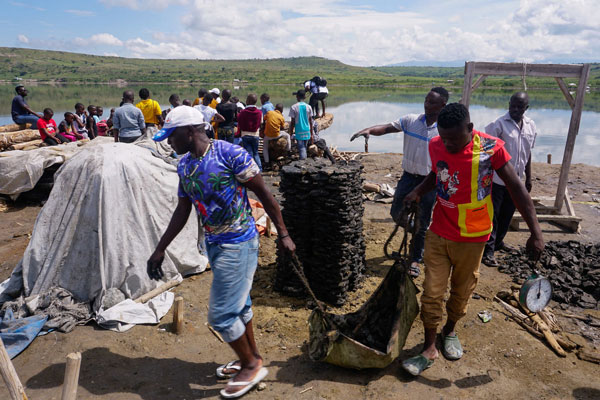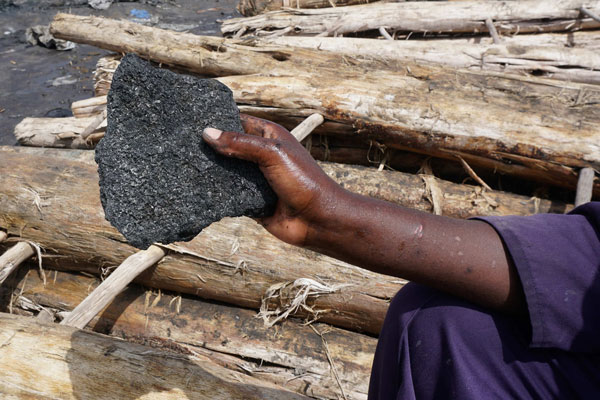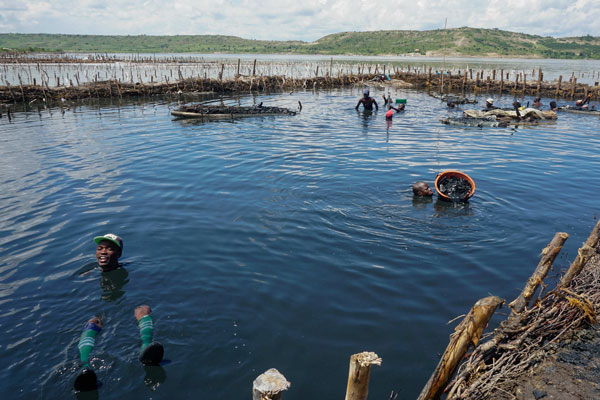
The unlicensed workers use what they have to combat health fears in Uganda’s top salt-producing lake. A new law is supposed to offer protections. So far, little is on the way.
LAKE KATWE, UGANDA | Edna Namara Global Press Journal Uganda | At first glance, the branches scratching the surface of Lake Katwe look like a gripping artwork for the way they create different shapes in the water. If, to an outsider’s eye, their arrangement may seem random, for the thousands of artisanal salt miners whose livelihoods depend on the lake, every branch serves a purpose as they are used to mark the borders of their salt pans.
“The divisions you see there are plots owned by us,” says Sarah Tinditiina, a salt miner who’s been working here for 13 years. Tinditiina spends her days scraping the lake bottom for rock salt. “We take long hours in the evaporating water and, because of this, I feel so thirsty.”
Located in Kasese district, in western Uganda, Lake Katwe is the top salt-producing lake in the country and a key resource for Uganda’s growing salt production industry, which, according to the United Nations Comtrade database, exported 7.4 United States dollars’ worth of salt in 2022 to other nations, including Democratic Republic of Congo, Rwanda and Sudan.
Artisanal mining refers to the manual extraction of minerals using basic tools by workers not officially employed by mining companies. The practice to extract salt from Lake Katwe is a centuries-old tradition dating to pre-colonial times. Many salt pans lining the lake’s shores have belonged to the same families for decades and were passed down from one generation to the next. In recent years, the lake has attracted an influx of job seekers, with an estimated 10,600 miners — mostly women — working here today. This represents a nearly 50% increase from a decade ago.
With weekly earnings ranging between 40,000 Ugandan shillings (10 dollars) and 1 million shillings (272 dollars), salt miners see the promise of a livelihood in the lake. But many also worry about their health.

Due to a lack of toilet facilities, salt miners immersed in waters for long periods of time are at risk of sewage-borne illnesses, such as typhoid, cholera and diarrhea, according to a 2018 report from the United Nations Development Programme. The report also found that prolonged exposure to brine can cause inflammation of reproductive organs and may affect miners’ fertility rates. Men reported deformed genitalia, and female miners said they experienced high rates of miscarriage and infertility.
Local medical experts interviewed by Global Press Journal, however, expressed skepticism about a correlation between salt water and low fertility rates. “The miners have a phobia that their parts will be affected but there is nothing that happens,” says Paul Kaduyu, a gynecologist at Mengo Hospital, in Kampala. Medical experts, however, confirm that brine exposure can lead to skin conditions that can be exacerbated by a lack of proper treatment, causing skin ulcers and infections.
When the Ugandan government approved the Mining and Minerals Act in 2022 to regulate the work of artisanal miners, Lake Katwe’s salt miners were hopeful it would address their concerns. Under the new law, the minister of Energy, Mining and Mineral Development may prescribe measures to make artisanal miners’ work safer, and so salt miners expected the government to facilitate access to protective gear. But this never happened for the thousands of salt miners who, like Tinditiina, are working in Lake Katwe without proper mining licenses. Many of them say the government didn’t consider their health concerns.
Without proper equipment, miners have mostly continued to rely on improvised protections. While men wear condoms or tie polythene bags around their genitals, female miners wear sanitary pads or smear mixed cassava dough on their genitalia before entering the salty waters.
“For the men, tying the penis for over seven hours tampers with the blood circulation in the vessels, which itself causes problems,” says Dr. Joel Mirembe, senior medical officer at Mulago National Referral Hospital.

Because women may not be able to afford pads every day, they often opt for old clothes, which may not be hygienic enough and could act as a “breeding ground for infections,” he adds.
In recent years, after news that salt miners were using condoms and pads as protective gear spread across the country, tourists and journalists began flocking to the lake.
“It became like a form of amusement for people to come and watch people who work with condoms on and women who pad themselves every workday of their lives,” says Nicholas Kagongo, a former leader at the Lake Katwe Cooperative Society, an organization representing local salt miners.
This was displeasing to the artisans, so they chose to hide the practice and not talk about it.
Ibrahim Bahati and Ronald Aguma sit on the pavement, demarcating their pans. They’ve been working in the lake for 25 years and 10 years, respectively. As a welcome gesture, Aguma extends a hand in greeting. “They are lies,” he says, referring to the use of condoms by male salt miners as protection. But he acknowledges the health risks of working in the lake. He thought the new law would improve their conditions.
“We thought they would think of us. We go through too much toil, and we risk our lives,” Aguma says. “We enter the lake by 9 a.m. and come out by 5 p.m. Naturally our body is shriveled because of too long a spell in water.”
He displays the effect the salt has had on him — some old and fresh cuts on his elbows — while Bahati, who has worked here longer, shows off a patchwork of scars that run down his legs.
“I started with not a single scar, but see what my legs have become,” Bahati says. To protect fresh wounds from the brine, miners use a cheap adhesive meant for metals that is unsuitable for human skin and may cause skin, eye and respiratory irritation.
Seka Abdullakarim, who has worked here for four years, plans to quit his job out of concerns for his health.
“I need to protect my life. I will need a generation under my name,” he says, referring to his desire to have children. When asked about what gear he uses to protect himself from the brine, he smiles and dodges the question by wading into the water, causing a ripple effect.
Margaret Akol, who has worked for 20 years as a leader of Women Salt Miners, a local organization representing women salt miners, disapproves of the miners’ reticence to talk about their working conditions.
“Embarrassing as it is, if a problem is kept hidden, there will be no solution,” she says.

Meanwhile, the government lacks adequate resources to improve salt miners’ working conditions, says Vincent Kedi, assistant commissioner for licensing and administration at the Directorate of Geological Survey and Mines. While medical professionals say condoms and pads can cause skin irritations and infections, Kedi says the government plans to start distributing these improvised protections. “The condoms and pads have kept them safe,” he says.
Kedi says some of the miners have reported having their uterus removed and claimed it was connected to brine exposure.
Global Press Journal could not independently verify this claim and the gynecologists interviewed for this article say it is highly unlikely that brine exposure may lead to uterus removal. Tinditiina says three of her fellow salt miners have had their uteruses removed.
“Our problems are more than what people think. It does not stop at our skin peeling or itching,” Tinditiina says. “Some of us have had the misfortune of losing our wombs.”
Not too far from where the miners work stands an abandoned salt factory, towering over the lake. It operated for less than one year in the early 1980s. Kagongo says that the building machinery could not withstand the waters’ corrosive effects. “The metal pipes used to drill the salt corroded in a month,” he says.
For salt miners, the abandoned factory serves as another painful reminder of the consequences the lake’s waters may have on their bodies. “If salt can destroy a machine in one year,” Bahati asks, “then what harm can it do to a human being who works in it for over 40 years?”
******
This story was originally published by Global Press Journal (link).
*****
✳ Global Press Journal is an award-winning international non-profit news publication that employs local women reporters in more than 40 independent news bureaus across Africa, Asia and Latin America.
 The Independent Uganda: You get the Truth we Pay the Price
The Independent Uganda: You get the Truth we Pay the Price



